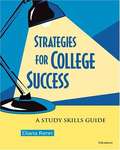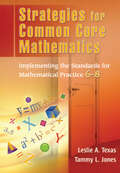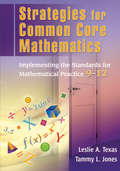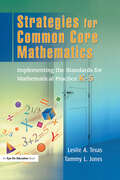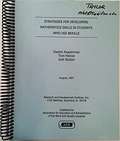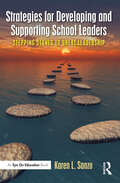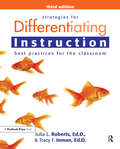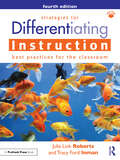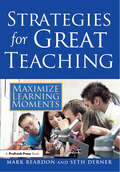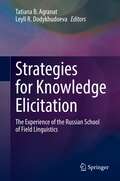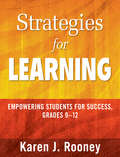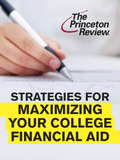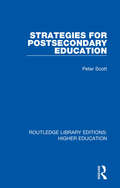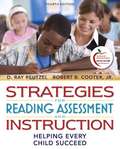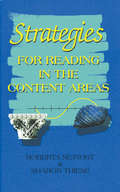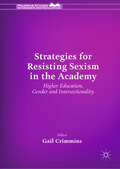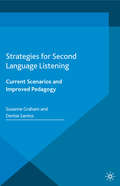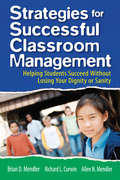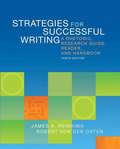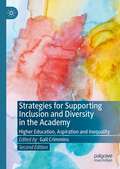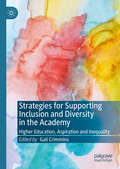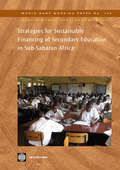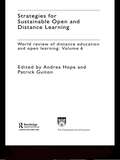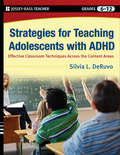- Table View
- List View
Strategies for College Success: A Study Skills Guide
by Diana RennStrategies for College Success introduces students to the language and culture of college. Designed primarily for near-native English speakers who are planning to attend or are just beginning their time at an American college, this textbook presents skills and strategies that will help students succeed academically and adjust to the cultural aspects of college life. It provides a wealth of study tips and strategies, which are outlined in the front of the book, to ensure academic success.
Strategies for Common Core Mathematics: Implementing the Standards for Mathematical Practice, 6-8
by Tammy Jones Leslie TexasThis new, practical book provides an explanation of each of the eight mathematical practices and gives middle school educators specific instructional strategies that align with the Common Core State Standards for Mathematics. Math teachers, curriculum coordinators, and district math supervisors get practical ideas on how to engage middle school students in mathematical practices, develop problem-solving skills, and promote higher-order thinking. Learn how to scaffold activities across grades and get strategies you can implement immediately in your classroom. All middle school mathematics educators should have this book in their professional libraries!
Strategies for Common Core Mathematics: Implementing the Standards for Mathematical Practice, 9-12
by Tammy Jones Leslie TexasThis new, practical book provides an explanation of each of the eight mathematical practices and gives high school educators specific instructional strategies that align with the Common Core State Standards for Mathematics. Math teachers, curriculum coordinators, and district math supervisors get practical ideas on how to engage high school students in mathematical practices, develop problem-solving skills, and promote higher-order thinking. Learn how to scaffold activities across grades and get strategies you can implement immediately in your classroom. All high school mathematics educators should have this book in their professional libraries!
Strategies for Common Core Mathematics: Implementing the Standards for Mathematical Practice, K-5
by Tammy Jones Leslie TexasThis new, practical book provides an explanation of each of the eight mathematical practices and gives elementary school educators specific instructional strategies that align with the Common Core State Standards for Mathematics.Math teachers, curriculum coordinators, and district math supervisors get practical ideas on how to engage elementary school students in mathematical practices, develop problem-solving skills, and promote higher-order thinking. Learn how to scaffold activities across grades and get strategies you can implement immediately in your classroom. All K-5 mathematics educators should have this book in their professional libraries!
Strategies for Developing Mathematics Skills in Students who Use Braille
by Gaylen KappermanStrategies for Developing Mathematics Skills in Students who Use Braille
Strategies for Developing and Supporting School Leaders: Stepping Stones to Great Leadership
by Karen L. SanzoStrategies for Developing and Supporting School Leaders assists personnel in school districts to deliver appropriate development and support practices for aspiring and current school leaders. This book explores a variety of research-based and best-practice processes that can be implemented in school districts to prepare leaders to meet the technical and adaptive demands of school leadership and the needs of a diverse student population. Sanzo lays out a cohesive framework of key processes and activities that range from the very simple and immediately implementable, to the more complex and nuanced. Providing both the "how," and "why," this important resource shares ideas, strategies, tools, and systems to develop effective and meaningful professional learning opportunities to help promote highly effective schools and districts.
Strategies for Differentiating Instruction: Best Practices for the Classroom
by Julia L. Roberts Tracy F. InmanThis updated edition of the best-selling Strategies for Differentiating Instruction offers practical strategies that allow all students to learn at appropriately challenging levels and make continuous progress by focusing on their various levels of knowledge and readiness to learn. Written in a teacher-friendly manner, the book presents strategies that can be used in any classroom to ensure that each student's needs are met. This third edition includes strategies for Common Core State Standards alignment plus new Developing and Assessing Products (DAP) tools for a variety of products. Designed specifically for teachers who are new to differentiated instruction, this book offers sound, practical advice for preassessing students, implementing differentiation strategies, and managing and assessing student learning. This book is filled with the essentials teachers need to know in order to differentiate instruction and address all students' needs, interests, and abilities.
Strategies for Differentiating Instruction: Best Practices for the Classroom
by Tracy Ford Inman Julia Link RobertsThis updated edition of Strategies for Differentiating Instruction offers practical approaches that allow all students to make continuous progress and be appropriately challenged by focusing on their various levels of knowledge and readiness to learn. Written in an accessible, teacher-friendly style, chapters explore methods to tier learning experiences so that all students’ unique learning needs are met. The new edition updates the strategies complete with student examples and provides Developing and Assessing Products (DAP) tools for a variety of products as reproducible appendices. Full of research-supported examples and designed specifically for teachers who are new to differentiated instruction, this book offers vetted, practical advice for preassessing students, implementing differentiation strategies, and managing and assessing student learning. This new edition is a must read for teachers seeking to master the essentials on how to differentiate instruction and address all students' needs, interests, and abilities.
Strategies for Differentiating Instructions
by Julia L. RobertsThis updated second edition of the best-selling Strategies for Differentiating Instruction offers practical strategies that allow all students to learn at appropriately challenging levels and make continuous progress by focusing on their various levels of knowledge and readiness to learn. Written in a teacher-friendly manner, the book presents strategies that can be used in any classroom to ensure that each student's needs are met. Educational Resource
Strategies for Great Teaching: Maximize Learning Moments
by Mark Reardon Seth DernerThis exciting, practical guide offers teachers easy-to-implement strategies that help students draw personal meaning from the curriculum. Filled with great tips for engaging learners, this book is a must for any teacher. The authors show how a variety of strategies—cooperative learning, direct instruction, inquiry, reflective writing, and experimentation—can be used to help learners bond with the content.Consider this a teacher-friendly guidebook for creating moments of genuine student understanding and comprehension. For example, this book offers lessons in which students:play the part of television reporters, interviewing other students about content they have learned;create visually complex pictures and graphs to represent information or concepts;use mathematical symbols to capture their understanding of relationship and events inherent in the content; andplay a classroom version of the old television game show The $10,000 Pyramid to identify patterns and seek meaning.Each strategy explored in this book provides a unique type of “e-moment” (engaging moment) that connects with students through their learning preferences and styles. Across the curriculum, teachers will learn how to better engage students and increase comprehension by adapting these strategies to their own specific needs.Educational Resource
Strategies for Knowledge Elicitation: The Experience of the Russian School of Field Linguistics
by Tatiana B. Agranat Leyli R. DodykhudoevaThis volume provides an overview of experimental methods, approaches, and techniques used by field linguists of the Russian school, and highlights the fieldwork experience of Russian scholars working in regions with a range of languages that differ genetically, typologically, and in the degree of their preservation.The collection presents language and sociolinguistic data relating to fieldwork in diverse languages: Uralic, Altaic, Paleo-Siberian, Yeniseian, Indo-European Iranian, Vietic, Kra-Day, and Mayan languages, as well as pidgin.The authors highlight the fieldwork techniques they use, and the principles underlying them.The volume’s multidisciplinary approach covers linguistic, ethnolinguistic, sociolinguistic, educational, and ethnocultural issues. The authors explore problems associated with the study of minority languages and indicate diverse and creative techniques for data elicitation. Close collaboration with speakers lies at the core of their approach. The collection presents strategies for eliciting systems of knowledge from mother-tongue speakers, triggering linguistic self-awareness, and providing semantic and morphosyntactic context for their languages.This publication is intended for academics, and for specialists in the field of linguistics and minority and indigenous languages. It will also benefit students as a guide to field research, as well as language activists, interested in documenting and preserving their mother tongue.
Strategies for Learning: Empowering Students for Success, Grades 9-12
by Karen J. RooneyThese explicit, reiterative strategies improve motivation, help struggling students "learn how to learn," and provide them with an effective skill set for all content areas.
Strategies for Maximizing Your College Financial Aid (College Admissions Guides)
by Princeton Review Kalman ChanyFiguring out how to pay for college can be daunting. Fortunately, Strategies for Maximizing Your College Financial Aid provides much-needed expert advice for understanding the financial aid process, managing student loans, and getting the most money for college. In this succinct guide, financial aid consultant Kal Chany and the experts at the Princeton Review present a concise but comprehensive overview of college financial aid. Inside, you'll find guidance to demystify the aid process, and information that will help you: · debunk financial aid myths · figure out financial aid terminology · evaluate financial aid packages and awards · understand grants, scholarships, student loans, work-study, and other forms of aid · fill out the FAFSA (Free Application for Federal Student Aid), CSS/PROFILE, and other financial aid forms · choose a college with financial aid in mind · get started on saving for school
Strategies for Postsecondary Education (Routledge Library Editions: Higher Education #26)
by Peter ScottOriginally published in 1975, Strategies for Postsecondary Education looks at how postsecondary education absorbs an increasing proportion of education budgets in developed countries. The book analyses the inequalities in the American postsecondary education system and compares its performance with France and the United Kingdom. The traditional concept of higher education with its preference for the college sector is now being challenged by the notion of postsecondary education which embraces the community colleges and preparatory schools in the United States and the polytechnics in Great Britain. The book argues that the development of the non-collegiate sector, including further education outside a formal educational context, will extend the range of educational opportunity and make much better use of limited resources.
Strategies for Reading Assessment and Instruction: Helping Every Child Succeed (4th Edition)
by D. Ray Reutzel Robert B. CooterThis best-selling book is a ready-reference for teachers of reading, a highly popular core text for reading diagnosis and assessment courses, and an ideal guide for ongoing professional development workshops. The unique format of the book, with its IF/THEN Strategy Guides that help readers quickly match student needs to research-proven strategies, make it a quick, effective, "point-of-teaching" resource of up to date information, strategies, and suggestions. In Strategies for Reading Assessment and Instruction Readers can quickly turn to current information on evidence-based assessment and instruction and find ways to assess, teach, and organize for effective and comprehensive reading instruction.
Strategies for Reading in the Content Areas
by Roberta L. Sejnost Sharon M. ThieseFormerly a SkyLight publication.Strategies for Reading in the Content Areas-excerpted from Reading and Writing Across Content Areas-describes the reading process and suggests strategies that can be used before, during, and after reading. Teachers will find examples for science, social studies, mathematics, and health. This handy booklet is a great, easy-to-access resource for content area teachers!
Strategies for Resisting Sexism in the Academy: Higher Education, Gender and Intersectionality (Palgrave Studies in Gender and Education)
by Gail CrimminsThis book harnesses the expertise of women academics who have constructed innovative approaches to challenging existing sexual disadvantage in the academy. Countering the prevailing postfeminist discourse, the contributors to this volume argue that sexism needs to be named in order to be challenged and resisted. Exploring a complex, intersectional and diverse arrangement of resistance strategies, the contributors outline useful tools to resist, subvert and identify sexist policy and practice that can be deployed by organisations and collectives as well as individuals. The volume analyses pedagogical, curriculum and research approaches as well as case studies which expose, satirise and subvert sexism in the academy: instead, embodied and slow scholarship as political tools of resistance are introduced. A call for action against the propagation of sexism and gender disadvantage in the academy, this important book will appeal to students and scholars of sexism in higher education as well as all those committed to working towards gender e/quality.
Strategies for Second Language Listening: Current Scenarios and Improved Pedagogy
by Suzanne Graham Denise SantosThis book seeks to help teachers teach listening in a more principled way by presenting what is known from research, exploring teachers' beliefs and practices, examining textbook materials, and offering practical activities for improving second language listening.
Strategies for Successful Classroom Management: Helping Students Succeed Without Losing Your Dignity or Sanity
by Brian D. Mendler Richard L. Curwin Allen N. MendlerHelp difficult students change negative behaviors with these strategies for teaching conflict resolution and anger management, handling power struggles successfully, helping students prevent bullying, and more.
Strategies for Successful Writing: A Rhetoric, Research Guide, Reader, and Handbook (Tenth Edition)
by James A. Reinking Robert von der OstenStrategies for Successful Writing keeps instruction brief and to-the-point so that students spend less time reading about writing and more time writing. Instruction delivered through extensive examples helps students see what different strategies look like when applied in real texts.
Strategies for Supporting Inclusion and Diversity in the Academy: Higher Education, Aspiration and Inequality
by Gail CrimminsThis book explores tried and tested strategies that support student and faculty engagement and inclusion in the academy. These strategies are anchored by a brief exploration of the history and effect/s of exclusion and deprivilege in higher education. However, while many publications exploring academic inequality focus on the causes and impacts of structural, psychological and cultural exclusion based on racism, sexism, classism and ableism, they rarely engage in interventions to expose and combat such de/privilege. Capturing examples of inclusive practices that are as diverse as student and faculty populations, these strategies can be easily translated and employed by organisations, collectives and individuals to recognise and combat social and academic exclusion within higher education environments.
Strategies for Supporting Inclusion and Diversity in the Academy: Higher Education, Aspiration and Inequality
by Gail CrimminsThis book explores tried and tested strategies that support student and faculty engagement and inclusion in the academy. These strategies are anchored by a brief exploration of the history and effect/s of exclusion and deprivilege in higher education. However, while many publications exploring academic inequality focus on the causes and impacts of structural, psychological and cultural exclusion based on racism, sexism, classism and ableism, they rarely engage in interventions to expose and combat such de/privilege. Capturing examples of inclusive practices that are as diverse as student and faculty populations, these strategies can be easily translated and employed by organisations, collectives and individuals to recognise and combat social and academic exclusion within higher education environments.
Strategies for Sustainable Financing of Secondary Education in Sub-Saharan Africa
by Keith M. LewinInvestment in secondary schooling in Sub-Saharan Africa has been neglected since the World Conference on Education for All at Jomtien. The World Education Forum at Dakar began to recognize the growing importance of post-primary schooling for development. Only 25 percent of school-age children attend secondary school in the region--and fewer complete successfully, having consequences for gender equity, poverty reduction, and economic growth. As universal primary schooling becomes a reality, demand for secondary schools is increasing rapidly. Gaps between the educational levels of the labor force in Sub-Saharan Africa and other regions remain large. Girls are more often excluded from secondary schools than boys. Secondary schooling costs are high to both governments and households. This study explores how access to secondary education can be increased. Radical reforms are needed in low-enrollment countries to make secondary schooling more affordable and to provide more access to the majority currently excluded. The report identifies the rationale for increasing access, reviews the status of secondary education in Sub-Saharan Africa, charts the growth needed in different countries to reach different levels of participation, identifies the financial constraints on growth, and discusses the reforms needed to make access affordable. It concludes with a road map of ways to increase the probability that more of Africa's children will experience secondary schooling.
Strategies for Sustainable Open and Distance Learning: World Review of Distance Education and Open Learning: Volume 6
by Andrea Hope Patrick GuitonAdaptability and the ability to handle rapid and ongoing change are essential for successfully managing any modern educational enterprise, and open and distance learning is no exception. In an often over-looked field, this volume examines the nature of sustainability in open and distance learning using case material from a wide range of current educational contexts worldwide. The books themes include: reflection and analysis of the management of change collaboration staff development quality assurance and funding in an increasingly globalized environment. This book also reassesses the core processes involved in course development, delivery, and student support, in a world that is both linked and divided by access to the latest technologies. In a rapidly changing world, this book shows how the path from policy to sustainable practice is rarely easy. However, through consistent attention and commitment to meeting the needs of learners, sustainability can be achieved.
Strategies for Teaching Adolescents with ADHD
by Silvia L. DeruvoADHD expert offers help for teaching the content areas to students with attention problemsWritten by an expert in the field of ADHD, this important resource offers strategies to teach adolescents with ADHD across all core content areas: English Language Arts, Math, Science, and Social Studies. These strategies have been classroom-tested and proven to engage students during content instruction so that they will gain a lasting understanding of the material taught. As students interact with the content--talk, write, draw, and create a variety of media in relation to the content--all students, including those with ADHD, will learn the basics necessary for post-secondary education and employment.Offers an important guide for teaching core content to adolescents with ADHDIncludes information for engaging ADHD students in a way that makes content memorableExplains how to use the strategies to teach all classroom studentsWritten by a nationally known authority on ADHDPublished in partnership with the acclaimed WestEd organization
